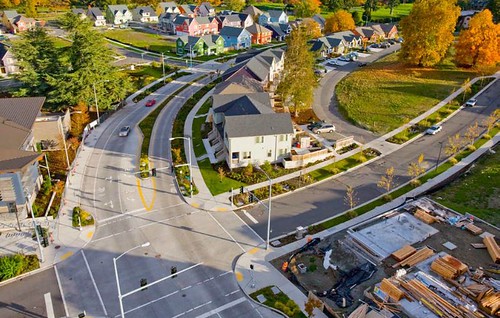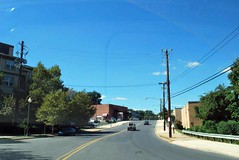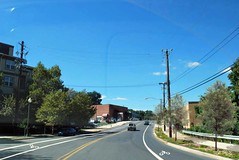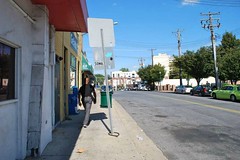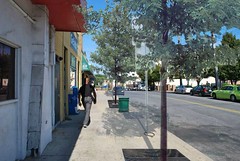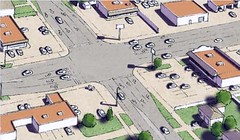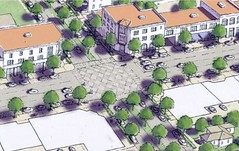Fixing suburbs with green streets that accommodate everyone

Posted December 20, 2011 at 1:39PM
We’ve made such a mess of the suburbs we constructed in the last fifty or so years that one wonders whether they can ever be made into something more sustainable. Strip malls, traffic jams, cookie-cutter subdivisions, diminished nature, almost no sense of outdoor community. We all know the drill: there are nice places to be in America’s recently built suburbs, but we have to know where they are and drive to them through a visual and environmental mess to get there.
One of the most challenging aspects of suburbs, and of the prescriptions for improving them, is the character of their roadways. Most of us take the poor design of our streets – the most visible part of most suburban communities, if you think about it – so much for granted that it never occurs to us that they actually could be made better for the community and for the environment. Consider, for example, main “arterial” streets so wide that pedestrians can’t cross them, even if there is a reason to; little if any greenery to absorb water, heat, or provide a calming influence; or residential streets with no sidewalks.
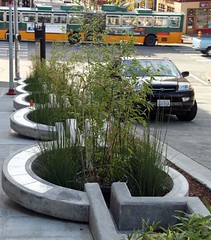 This is where Montgomery County, Maryland’s new streetscape initiative comes in. Just northwest of Washington with a boundary just a couple of miles from my DC home, Montgomery has had its ups and downs over the years accommodating and managing tremendous growth. But there is no question that it has done some things right, including the preservation of much of its farmland – in part by channeling growth into the central districts of Bethesda and Silver Spring, both served by DC’s Metro rail transit system, and more recently by encouraging walkable redevelopment along the notoriously sprawled-out Rockville Pike corridor.
This is where Montgomery County, Maryland’s new streetscape initiative comes in. Just northwest of Washington with a boundary just a couple of miles from my DC home, Montgomery has had its ups and downs over the years accommodating and managing tremendous growth. But there is no question that it has done some things right, including the preservation of much of its farmland – in part by channeling growth into the central districts of Bethesda and Silver Spring, both served by DC’s Metro rail transit system, and more recently by encouraging walkable redevelopment along the notoriously sprawled-out Rockville Pike corridor.
As a result, Montgomery has actually been in the business of “retrofitting” or “repairing” the suburbs (very gradually, to be sure) since before planners began to call it that. Now, it has undertaken a pilot study on two stretches of roadway in the county to evaluate the use of green infrastructure – strategically placed vegetation and other methods that reduce polluted runoff by using or mimicking natural hydrology – along with measures to better accommodate pedestrians and bicyclists . One is an arterial road that goes through residential areas, the other a wide commercial street. Both showed there was much potential, and Montgomery is now planning to integrate more environmental features into its streets.
Here’s how the county’s web site describes the initiative:
“Streetscapes and public rights-of-way are valuable real estate, although people often forget they are not just about moving motor vehicles. They are also the front doors to homes, schools and businesses. As Montgomery County urbanizes and its spaces become more constrained, planners are re-considering how to create more value from our streetscapes.
“The Planning Department conducted a year-long project on environmental site design (ESD) focused on street edges. ESD integrates site design, natural hydrology, and other controls to capture and treat runoff.
“In addition to collecting drainage and wastewater, roadsides accommodate utilities, as well as provide space for pedestrians and off-road bicyclists, but trees and natural vegetation have often taken a back seat to other uses.
“This project has resulted in plans for retrofitting road sections in suburban and urban areas to better handle stormwater and improve the environment for pedestrians and cyclists in addition to motorists. Planners are working with County agencies and the County Council to establish policies to encourage ESD practices along county roads.”
Montgomery hired SvR Design Company, a Seattle-based firm with extensive experience in green infrastructure and complete streets/walkability planning, to advise the initiative. Many of the images accompanying this post were contributed to the planning effort by SvR to illustrate the possibilities. Note that the changes are not extensive, for the most part, but incremental: subtle narrowing of traffic lanes to slow auto speed; street trees and plantings in medians and along sidewalks – and even in parking lots – to capture and filter rainwater, while bringing more nature back into the community; bike lanes and wider sidewalks to better accommodate non-motorized users; striping to mark a people-first pedestrian lane where a sidewalk may not be feasible.
In addition to SvR’s images for Montgomery, I also wanted to show a before-and after illustration from Galina Tachieva’s fascinating Sprawl Repair Manual so that readers can imagine what an ambitious street makeover might look like when coupled with suburban redevelopment. Note especially the medians, street trees and, in the intersection, porous pavement that both filters additional stormwater and signals the presence of a distinct zone in the roadway where pedestrians are likely to be crossing. (Tachieva’s book is one of two great resources on fixing suburbs to emerge in the last three years; the other is Retrofitting Suburbia, by Ellen Dunham-Jones and June Williamson.)
There’s a lot to like about Montgomery’s initiative, including that it brings together three relatively new and successful – but often independently successful – lines of sustainability thinking and planning: redesigning suburbs; green infrastructure; and “complete streets” that accommodate all types of users. It reminds us that the greatest potential for sustainable communities lies with the integration of ideas and purposes. I hope this kind of initiative continues to catch on.
Move your cursor over the images for credit information.
Please also visit NRDC’s sustainable communities video channel.
